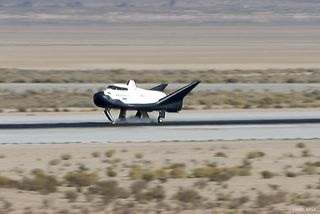Dream Chaser space plane gets FAA approval to land at Alabama airport
The private spacecraft could be flying cargo missions to the space station as soon as 2023.

Cargo missions returning from the International Space Station are now authorized to touch down in the Cotton State.
The U.S. Federal Aviation Administration (FAA) just issued a license allowing the Huntsville International Airport in Alabama to accept landings from Sierra Space's Dream Chaser space plane when the vehicle starts flying. That said, Sierra Space (or any other provider) will still need a vehicle operator license before reentering over the airport, FAA officials noted.
Documents previously submitted to the FAA for the environmental review suggest that Sierra Space is targeting 2023 for its landings at the Alabama facility.
"The license permits the airport to offer its site for Sierra Space Dream Chaser vehicles returning to Earth from future NASA resupply missions to the International Space Station. The reentry site operator license is valid for five years," the FAA stated on Friday (May 13).
"The FAA license evaluation process involved environmental and safety reviews," FAA officials added. "In addition, the FAA will work with the airport to develop the necessary notifications and other procedures for safely and efficiently integrating commercial space reentries into its operations."
In pictures: Sierra Nevada's Dream Chaser aces glide test flight

Sierra Nevada has a contract with NASA to fly at least six uncrewed cargo missions to and from the ISS with Dream Chaser. The flights will lift off on United Launch Alliance Vulcan Centaur rockets from Florida's Cape Canaveral Space Force Station.
Get the Space.com Newsletter
Breaking space news, the latest updates on rocket launches, skywatching events and more!
In 2021, Sierra Nevada announced that the cargo version of Dream Chaser would land on NASA's former space shuttle runway at the Launch and Landing Facility, at the agency's Kennedy Space Center in Florida. The company is also considering landings in Japan, according to a recent SpaceNews report, and said it plans to send its first mission aloft in 2023.
Sierra Nevada first envisioned Dream Chaser as a crew vehicle and targeted ISS astronaut flights for this version. That said, NASA eventually selected SpaceX and Boeing to carry crews to and from the ISS. Sierra Nevada has not ruled out building a crewed version of the space plane.
Two companies — SpaceX and Northrop Grumman — already fly robotic cargo missions to the orbiting lab for NASA. SpaceX uses the robotic version of its Dragon capsule, which can return experiments to Earth, while Northrop Grumman's Cygnus spacecraft burn up in the atmosphere during re-entry.
Follow Elizabeth Howell on Twitter @howellspace. Follow us on Twitter @Spacedotcom and on Facebook.
Join our Space Forums to keep talking space on the latest missions, night sky and more! And if you have a news tip, correction or comment, let us know at: community@space.com.

Elizabeth Howell (she/her), Ph.D., is a staff writer in the spaceflight channel since 2022 covering diversity, education and gaming as well. She was contributing writer for Space.com for 10 years before joining full-time. Elizabeth's reporting includes multiple exclusives with the White House and Office of the Vice-President of the United States, an exclusive conversation with aspiring space tourist (and NSYNC bassist) Lance Bass, speaking several times with the International Space Station, witnessing five human spaceflight launches on two continents, flying parabolic, working inside a spacesuit, and participating in a simulated Mars mission. Her latest book, "Why Am I Taller?", is co-written with astronaut Dave Williams. Elizabeth holds a Ph.D. and M.Sc. in Space Studies from the University of North Dakota, a Bachelor of Journalism from Canada's Carleton University and a Bachelor of History from Canada's Athabasca University. Elizabeth is also a post-secondary instructor in communications and science at several institutions since 2015; her experience includes developing and teaching an astronomy course at Canada's Algonquin College (with Indigenous content as well) to more than 1,000 students since 2020. Elizabeth first got interested in space after watching the movie Apollo 13 in 1996, and still wants to be an astronaut someday. Mastodon: https://qoto.org/@howellspace
